How Pallet Inverters Solve Precision Automation in Lean Manufacturing Plants in Germany?
Lean manufacturing plants in Germany operate under immense pressure. They chase perfection in efficiency. But a common problem often creates a major bottleneck: handling palletized goods. You might have goods arriving on wooden pallets that can't enter your cleanroom. You might need to switch to in-house plastic pallets for your automated warehouse. Or you might simply have a damaged pallet that threatens to stop the entire production line. This manual handling process is a weak link in an otherwise strong chain. It slows everything down. This is not just a small delay. It's a direct attack on your Overall Equipment Effectiveness (OEE). Each time a worker has to manually restack a pallet, every stop, every damaged box, it all adds up. In the high-stakes world of German automotive or pharmaceutical manufacturing, these small issues become huge cost centers. It goes against the very idea of lean principles. What if you could automate this entire, problematic step? The pallet inverter is the answer. It is a machine that provides a precise, automated solution for these transfers. It removes the need for manual labor, protects your products, and fits perfectly into high-speed, automated lines.
Pallet inverters solve precision automation challenges in German lean manufacturing by replacing manual pallet exchange with a fully automated, controlled process. This integration boosts production speed, eliminates human error, protects goods from damage, and enables seamless transitions between different pallet types, which is essential for maintaining the continuous flow required by lean principles.
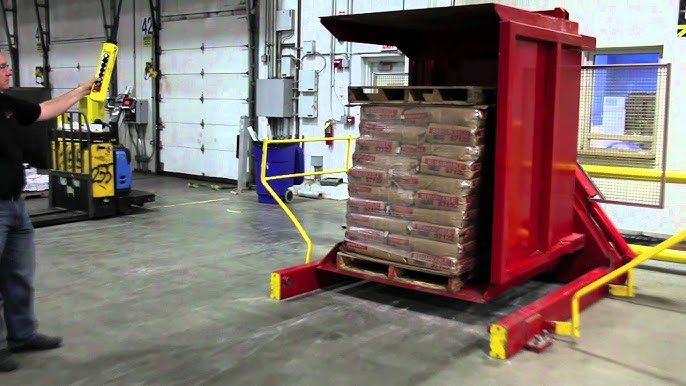
I've seen this solution work wonders in many factories. It’s amazing how a single, focused piece of equipment can resolve so many problems. From my journey as an engineer to building my own factory, I learned that the most effective solutions are often the ones that solve a simple, recurring problem perfectly. You are likely wondering how this machine actually fits into a complex manufacturing environment. How does it really boost efficiency and safety? Let's break it down. We will look at the specific ways a pallet inverter becomes a key part of precision automation. We will explore its impact on workflow, product safety, system integration, and your financial return.
How do Pallet Inverters Enhance Workflow Efficiency in German Factories?
In a precision German factory, every second is valuable. A very common bottleneck happens at the receiving dock. Your materials arrive on external pallets. These are often made of wood and can be low-quality or damaged from transit. These pallets are not suitable for your internal automated systems, like an Automated Guided Vehicle (AGV) network or a high-bay warehouse. They certainly can't enter a cleanroom environment in the food or pharmaceutical industry. The traditional solution is to manually re-palletize the goods. This process is slow, inefficient, and breaks the smooth flow of materials. It is a major disruption. This manual stop creates a traffic jam. Forklifts have to wait in line. Workers are pulled away from their primary, value-added tasks. The production line might even be starved for materials because of this delay at the beginning of the process. This situation is the exact opposite of the smooth, predictable Takt time that is the hallmark of world-class German manufacturing. A pallet inverter completely fixes this problem by automating the handover. It creates a dedicated, high-speed transfer station. An incoming pallet is loaded, the machine safely inverts the load, the shipping pallet is removed, and your clean, standardized in-house pallet is put in its place. This entire cycle can take as little as 60 seconds. It feeds your internal logistics systems without a single pause in the overall factory rhythm.
Pallet inverters enhance workflow efficiency by creating a fast, automated bridge between external logistics and internal automated systems. They eliminate the manual, time-consuming task of re-palletizing, allowing for a continuous, uninterrupted flow of materials from the receiving bay to the production line, which is critical for lean manufacturing.
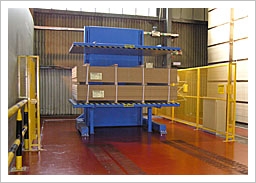
Let's dive deeper into the real-world impact on your workflow. The difference between a manual process and an automated one is night and day. It’s a core principle I learned early in my career: identify the biggest source of delay and apply the right technology to it. For many of my clients, that source was pallet handling.
The Manual Bottleneck: A Step-by-Step Problem
Without a pallet inverter, the process at the receiving dock is a chain of inefficiencies.
- Arrival and Queuing: A truck arrives. A forklift driver unloads a pallet and brings it to a staging area. If other pallets are already being processed, the forklift and its driver must wait. This is unproductive time.
- Manual Labor Allocation: Two or more workers must be assigned to the re-palletizing task. These are often skilled workers who could be doing something more valuable.
- The Unstacking/Restacking Process: The workers manually unstack the boxes, bags, or other items from the original pallet. They place them onto a new, clean, in-house pallet. This is physically demanding and slow. The risk of dropping and damaging a product is very high.
- Waste Handling: The old, often broken wooden pallet must be removed and disposed of. This is another non-value-added step.
- Introduction to Internal Flow: Finally, the new pallet can be picked up by another forklift or an AGV to be taken into the warehouse or to the production line. The entire sequence can take 5-10 minutes per pallet and is prone to variation.
The Automated Flow: A Lean Solution
Now, let's look at the same scenario with a pallet inverter integrated into the workflow.
- Direct Placement: The forklift driver takes the pallet directly from the truck and places it into the pallet inverter. There is no queue, no waiting.
- Automated Cycle: The operator presses a single button. The machine's PLC takes over. It clamps the load securely, rotates it 180 degrees, the platform separates to allow the old pallet to be removed, the new pallet is inserted, and the machine rotates back. The entire cycle is complete in about 60-90 seconds.
- Seamless Handover: The new, perfectly stacked pallet is now ready for the internal AGV or conveyor system. The process is predictable, fast, and requires minimal human interaction.
| Feature | Manual Re-palletizing | Automated Pallet Inverter |
|---|---|---|
| Time per Pallet | 5-10 minutes | 1-1.5 minutes |
| Labor Required | 2-3 Workers | 1 Operator (part-time) |
| Workflow | Stop-and-Go, Unpredictable | Continuous, Predictable |
| Product Damage Risk | High | Extremely Low |
| Ergonomic Risk | High (lifting, bending) | None |
| Floor Space | Large staging area needed | Compact machine footprint |
This transition from a manual bottleneck to an automated flow state is fundamental to lean manufacturing. It directly addresses the goal of increasing capacity utilization by ensuring a steady, reliable stream of materials to your production lines.
What Role Do Pallet Inverters Play in Maintaining Product Integrity and Safety?
You have invested a great deal of money and effort to manufacture a perfect product. But during the final handling stages, a single mistake can ruin it. A box is dropped during manual restacking. A heavy bag is torn. An unstable stack of goods topples over. This product damage is a hidden cost that slowly eats away at your profit margins. It's a problem I've seen too many times. Even worse than product damage is the risk to your employees. Manual lifting of heavy and awkward loads is a primary cause of workplace injuries, especially back injuries. A single serious accident can result in lost work time, high insurance claims, and significant damage to your company's reputation as a safe employer. In a country with high standards like Germany, this is a major concern for any factory owner. A pallet inverter addresses both of these issues with mechanical precision. The machine uses a powerful and controlled clamping system to secure the product from both the top and bottom before it begins to gently rotate the load. There is no manual lifting. There is no chance of dropping individual items. This method provides a guarantee for both the integrity of your product and the safety of your operators.
Pallet inverters play a crucial role in maintaining product integrity by securing the load with controlled pressure before rotation, eliminating the risk of damage from manual handling. They also significantly improve operator safety by removing the need for physical lifting, which prevents injuries and aligns with Germany's strict occupational health and safety standards.
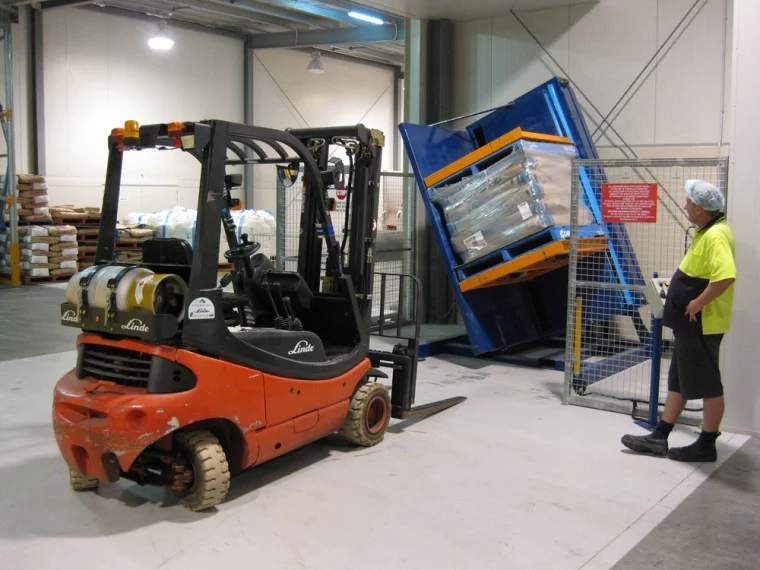
When I started my own packing machine factory, my first principle was that the machine must protect the product and the person operating it. This is not just a feature; it's a core responsibility. A pallet inverter is a perfect example of this principle in action. Let's look closer at the mechanics and the safety implications.
How Clamping Mechanisms Protect Your Goods
The genius of the pallet inverter is not in the rotation itself, but in how it holds the load during rotation. It's not a simple clamp.
- Adjustable Pressure: Modern inverters have pressure-sensitive clamping. You can set the exact amount of force needed for different products. For robust goods like bags of cement, you can use high pressure. For delicate items like boxes of pharmaceuticals or food items, you can use very light pressure. This prevents crushing.
- Soft Padding and Liners: The clamping tables can be fitted with soft rubber or polyurethane pads. This further protects the packaging from marks or scuffs. For extremely sensitive products, custom liners can be used.
- Side Support Walls: For loads that are not perfectly stable, such as stacks of pails or unevenly packed boxes, pallet inverters can be equipped with side-support walls. These walls hold the load together from the sides during the inversion process, ensuring the stack remains perfectly aligned.
I remember visiting a client's facility that produced steel wire. They were manually tilting heavy, unstable coils to change pallets. The rate of product damage and worker injury was a constant headache for the plant manager. We designed a custom tilter for them, which is a close cousin to a pallet inverter. After installation, their product damage claims in that department fell by over 90%, and their accident reports dropped to nearly zero. It proved that applying the right gentle-handling technology is a powerful investment.
Eliminating Ergonomic Hazards and Ensuring Compliance
Worker safety is not just an ethical issue; it's a financial one.
- Preventing Musculoskeletal Disorders (MSDs): Manual re-palletizing involves repeated lifting, bending, and twisting—all classic causes of MSDs. These injuries are costly, leading to medical expenses, lost productivity, and potential legal issues. A pallet inverter eliminates this manual work entirely.
- Compliance with Standards: In Germany, workplace safety is governed by strict regulations, often enforced by the "Berufsgenossenschaft" (the trade association for statutory accident insurance). Investing in equipment like a pallet inverter is a proactive measure that demonstrates a commitment to safety and helps ensure compliance.
| Risk Factor | Manual Handling | With Pallet Inverter |
|---|---|---|
| Product Damage | High risk of drops, crushing, tears | Negligible, controlled clamping |
| Operator Injury | High risk of back/shoulder strain | Eliminated, no manual lifting |
| Process Consistency | Low, depends on worker | High, machine-controlled |
| Compliance Risk | Moderate to High | Low, engineered safety solution |
By making the process mechanically sound, you remove the variables of human error and physical strain. This protects your two most important assets: your products and your people.
How Do Pallet Inverters Integrate with Existing Automation and MES Systems?
You have made a significant investment in building a smart factory. You have a sophisticated Automated Guided Vehicle (AGV) system that moves materials efficiently. You have a state-of-the-art Warehouse Management System (WMS) that tracks every item. But these advanced systems have a critical requirement: they need perfectly positioned loads on standardized pallets to function correctly. If your pallet exchange process is still a manual, offline task, you have created a major roadblock for your digital transformation. It's like having a superhighway with a dirt-road entrance ramp. This "analogue hole" in your otherwise digital factory creates serious problems. Your Manufacturing Execution System (MES) and WMS have no visibility into this crucial step. This leads to data gaps, inventory inaccuracies, and operational inefficiencies that undermine your entire automation strategy. Modern pallet inverters are designed for exactly this challenge. They are built for Industry 4.0. They integrate seamlessly into your factory's ecosystem. Equipped with PLCs, sensors, and standard communication protocols like PROFINET or EtherNet/IP, they can "talk" directly to your factory's central control systems. The pallet inverter stops being an isolated machine and becomes another intelligent node in your fully automated environment.
Pallet inverters integrate with existing automation by functioning as a smart, connected station. Equipped with PLCs and sensors, they communicate with AGVs, conveyor systems, and MES platforms to report their status, confirm cycle completion, and receive commands, ensuring a fully synchronized and data-rich lean manufacturing environment.
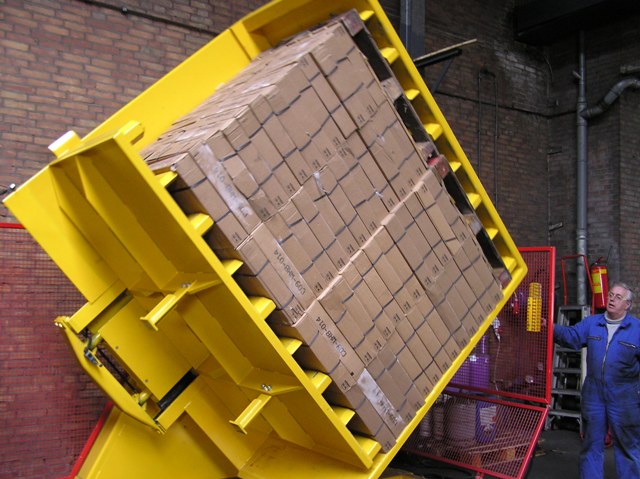
As an engineer who has helped clients connect different pieces of machinery, I know that true automation is about communication. It's not enough for machines to do their job; they have to talk to each other. A modern pallet inverter is designed to be a great communicator. Let's look at the technical side of this integration.
The Communication Bridge: PLCs, Sensors, and Networks
A pallet inverter is more than just a motor and a frame. It's a piece of mechatronic equipment with its own intelligence.
- The PLC (Programmable Logic Controller): This is the brain of the inverter. It controls the sequence of operations: clamping, rotating, unclamping. More importantly, it manages communication with the outside world. It can be programmed to follow complex logic, such as waiting for a signal from an AGV before starting its cycle.
- Sensors: A network of sensors provides real-time feedback. Photoelectric sensors confirm that a pallet is in the correct position. Proximity sensors verify that the clamps are closed. Laser sensors can even check that the load is stable before rotation begins. This sensor data ensures safe and error-free operation.
- Communication Protocols: The PLC uses standard industrial network protocols like PROFINET (common in Germany with Siemens systems) or EtherNet/IP (common with Rockwell/Allen-Bradley systems). This allows for a simple, robust connection to your main factory network. The inverter can then easily exchange data with other PLCs on conveyors, AGVs, or the central WMS.
Data for Your MES and a Smarter Factory
Integration isn't just about making things move; it's about collecting data to get smarter. A connected pallet inverter can provide a stream of valuable information to your MES.
- Cycle Times: How long does each pallet exchange take? This helps you monitor efficiency and spot potential maintenance issues if times start to increase.
- Pallet Counts: The machine provides an exact count of pallets processed. This is crucial for inventory tracking and production reporting.
- Fault Codes: If there's a problem, the inverter can send a specific fault code to the central control room. This allows maintenance to diagnose the issue remotely and respond faster.
- Operational Hours: Tracking run time is essential for scheduling predictive maintenance, which is a key goal for any modern factory aiming for 95% uptime.
| System | Integration Method | Data Exchanged |
|---|---|---|
| AGV / Conveyor | Simple I/O Signals or Ethernet | "Ready to Load", "Cycle Complete", "Fault" |
| WMS / MES | Industrial Ethernet (PROFINET) | Cycle Count, Cycle Time, Machine Status, Fault Logs |
| Safety System | Hardwired Safety Relays / Safety PLC | Light Curtains, E-Stops, Area Scanners |
By integrating the pallet inverter, you close the data loop. You achieve the goal of comprehensive production visualization. You transform a manual, invisible process into a transparent, measurable, and controllable part of your smart factory.
What is the ROI for a Pallet Inverter in a High-Cost Environment like Germany?
In an economy like Germany's, every business decision is scrutinized. Labor costs are high. Factory floor space is a premium asset. Any new piece of equipment must justify its cost and its footprint, and it must do so quickly. At first glance, a pallet inverter might seem like just another expense to add to the budget. It takes up space and requires a capital investment. But this is the wrong way to look at it. The real question is: what is the cost of not having one? Without this automation, you are paying skilled, expensive workers to do a low-value, physically demanding, repetitive task. You are losing money every time a product is damaged during manual handling. You are losing valuable production time because of bottlenecks at your receiving dock. These hidden, ongoing costs are often far greater than the one-time investment in a machine. A pallet inverter delivers a clear, rapid, and compelling return on investment (ROI). It immediately frees up labor for more important tasks. It virtually eliminates costs from product damage. It increases throughput by streamlining your workflow. And it reduces the risk of expensive workplace injury claims. In a high-cost environment, this massive gain in efficiency translates directly to a healthier and more competitive bottom line.
The ROI for a pallet inverter in a high-cost environment like Germany is achieved through significant operational cost reductions. Key factors include the reallocation of manual labor to value-added tasks, elimination of costs associated with product damage and workplace injuries, and increased throughput, which boosts overall factory productivity and profitability.
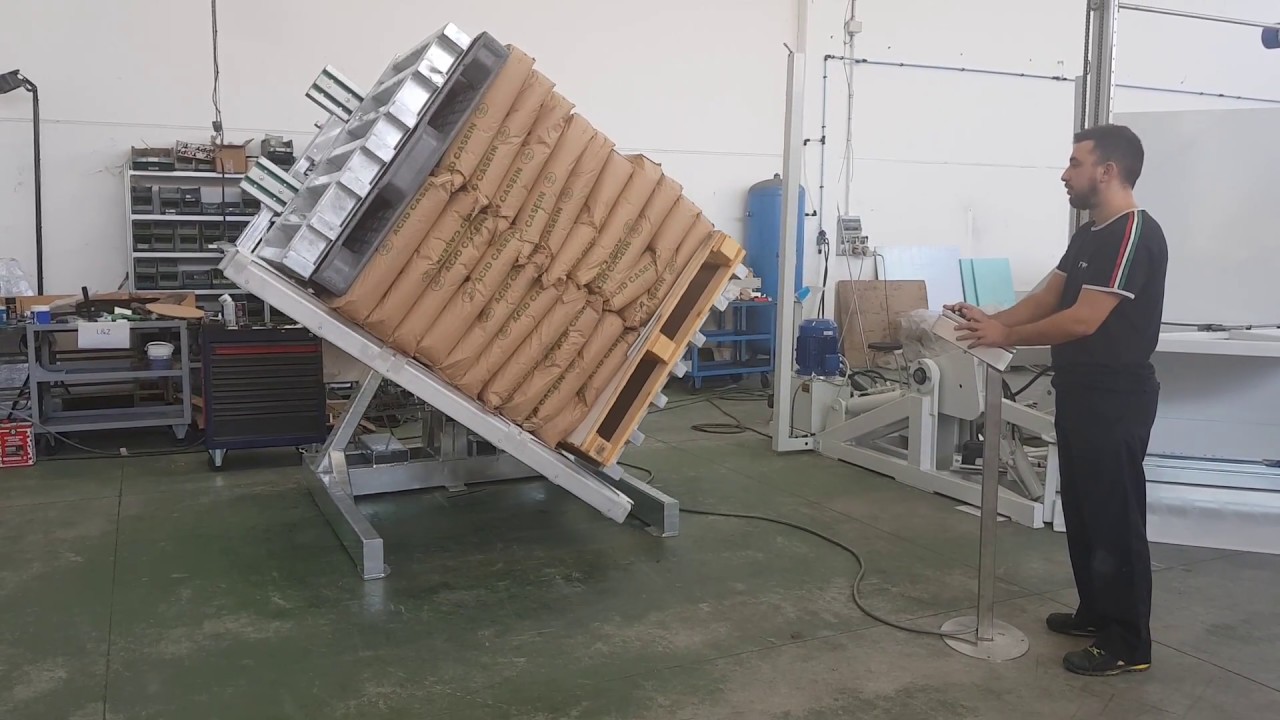
When I founded SHJLPACK, it was after years of seeing how the right machine could make a business more profitable. My own financial success came from helping clients achieve their financial goals. A machine is not a cost; it's a tool for generating value. Let's break down how you can calculate the ROI for a pallet inverter in a practical way.
Calculating the Tangible, Hard Savings
These are the numbers you can easily track and present to your finance department. We can use conservative estimates for a typical German manufacturing plant.
- Labor Savings: Manual re-palletizing requires at least two workers. A pallet inverter requires one operator, and often only for a fraction of their time. Let's say you can reallocate 1.5 full-time employees to other tasks. In Germany, the fully-loaded cost of an industrial worker can be €60,000 per year or more.
- Annual Labor Savings = 1.5 workers €60,000/worker = €90,000*
- Damage Reduction Savings: Assume your company loses 0.5% of incoming goods value to handling damage, and you receive €20 million in goods per year through that dock.
- Current Annual Damage Cost = €20,000,000 0.5% = €100,000*
- A pallet inverter can reduce this by at least 90%.
- Annual Damage Savings = €100,000 90% = €90,000*
- Throughput Increase: This is harder to calculate, but very real. If the pallet bottleneck causes just 30 minutes of production line downtime per day, over a 250-day work year, that's 125 hours of lost production. If your line's operational value is €1,000/hour, that's a significant loss.
- Annual Throughput Value Gained = 125 hours €1,000/hour = €125,000*
The Intangible, Yet Critical, Benefits
Beyond the hard numbers, there are other benefits that add tremendous value.
- Improved Safety and Morale: Reducing the risk of injury leads to lower insurance premiums and a happier, more stable workforce.
- Enhanced Quality and Consistency: Automated handling means every pallet is treated the same, improving quality control and customer satisfaction.
- Strengthened Compliance and Brand Image: Proactively investing in safety and efficiency enhances your reputation as a modern, responsible employer and a reliable supplier.
| Cost/Benefit Item | Calculation | Estimated Annual Value |
|---|---|---|
| INVESTMENT (One-Time) | Pallet Inverter Cost (incl. installation) | (€80,000) |
| SAVINGS: Labor | Reallocation of 1.5 FTEs | + €90,000 |
| SAVINGS: Damage | 90% reduction in handling damage | + €90,000 |
| GAIN: Throughput | Elimination of downtime | + €125,000 |
| Total Annual Gain | Sum of Gains | + €305,000 |
| Payback Period | Investment / Annual Gain | ~3.2 months |
Even with conservative numbers, the financial case is extremely strong. This directly addresses the core goals of reducing operating costs and improving profit margins. An investment that pays for itself in a few months is not a cost; it's a powerful strategic advantage.
Conclusion
Pallet inverters are not just machines; they are strategic tools. They help you achieve true lean efficiency, especially in demanding environments like Germany, unlocking precision, safety, and a smarter workflow.



